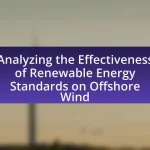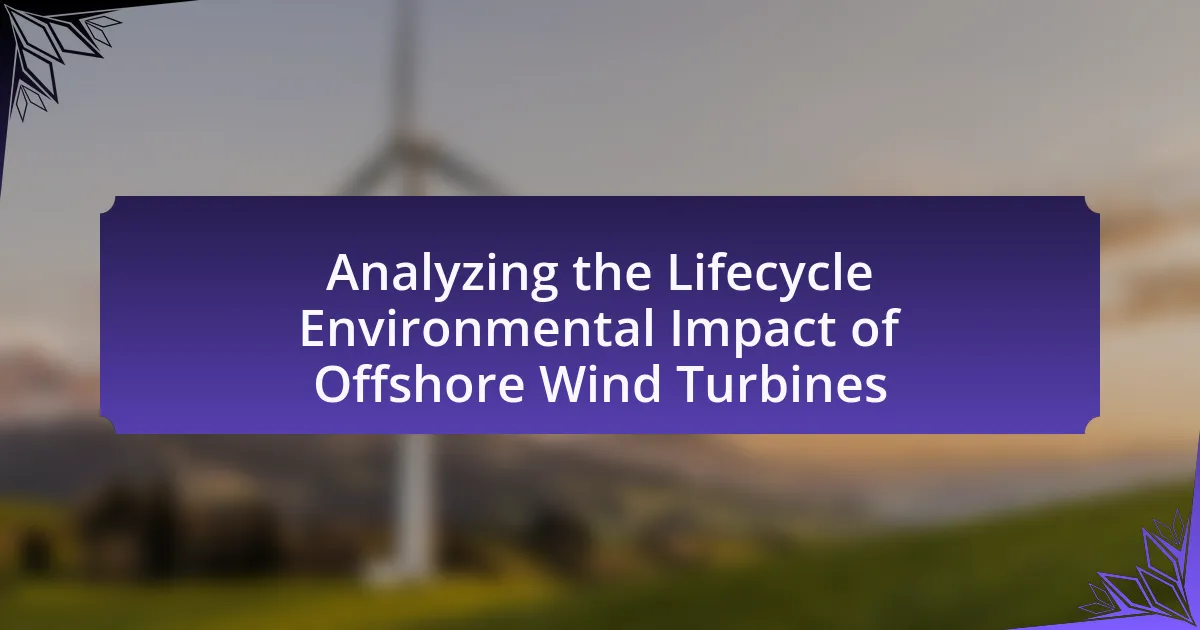Environmental Impact Assessments (EIAs) are essential tools in the planning and implementation of offshore wind energy projects, serving to evaluate potential environmental effects prior to project execution. This article outlines the significance of EIAs in promoting sustainability by assessing impacts on marine ecosystems, wildlife, and local communities, while also facilitating informed decision-making. Key components of EIAs, including baseline studies, impact analysis, and stakeholder engagement, are discussed, along with the methodologies employed and the challenges faced in data collection and regulatory compliance. Additionally, the article highlights emerging trends and innovations in EIAs, emphasizing their role in enhancing project design and ensuring adherence to environmental regulations.
What is the Role of Environmental Impact Assessments in Offshore Wind Energy Projects?
Environmental Impact Assessments (EIAs) play a crucial role in offshore wind energy projects by evaluating the potential environmental effects before project implementation. EIAs ensure that decision-makers consider ecological, social, and economic impacts, facilitating informed choices that promote sustainability. For instance, EIAs assess impacts on marine ecosystems, bird migration patterns, and local communities, which helps in minimizing adverse effects and enhancing project design. Regulatory frameworks in many countries mandate EIAs for offshore wind projects, reinforcing their importance in safeguarding environmental integrity while advancing renewable energy initiatives.
Why are Environmental Impact Assessments important for Offshore Wind Energy Projects?
Environmental Impact Assessments (EIAs) are crucial for Offshore Wind Energy Projects because they systematically evaluate the potential environmental effects of these projects before they are implemented. EIAs help identify and mitigate adverse impacts on marine ecosystems, wildlife, and local communities, ensuring that development is sustainable and responsible. For instance, a study by the European Commission highlighted that EIAs can reduce project-related conflicts and enhance stakeholder engagement, leading to better project outcomes and compliance with environmental regulations.
What are the key objectives of conducting Environmental Impact Assessments?
The key objectives of conducting Environmental Impact Assessments (EIAs) are to identify, predict, evaluate, and mitigate the potential environmental impacts of proposed projects. EIAs aim to ensure informed decision-making by providing comprehensive information about the environmental consequences of a project before it is approved. This process includes assessing effects on biodiversity, air and water quality, and local communities, thereby promoting sustainable development. Furthermore, EIAs facilitate public participation and transparency, allowing stakeholders to voice concerns and contribute to the planning process, which is essential for projects like offshore wind energy initiatives that may affect marine ecosystems and coastal communities.
How do Environmental Impact Assessments contribute to sustainable development?
Environmental Impact Assessments (EIAs) contribute to sustainable development by systematically evaluating the potential environmental effects of proposed projects before they are approved. This proactive approach allows for the identification and mitigation of negative impacts on ecosystems, biodiversity, and local communities, ensuring that development projects align with sustainability goals. For instance, EIAs often incorporate stakeholder engagement, which fosters community involvement and transparency, leading to more socially responsible outcomes. Additionally, studies have shown that projects with thorough EIAs tend to have better long-term environmental performance, as they are designed to minimize harm and promote resource conservation.
What are the main components of Environmental Impact Assessments in Offshore Wind Energy Projects?
The main components of Environmental Impact Assessments (EIAs) in Offshore Wind Energy Projects include baseline environmental studies, impact analysis, mitigation measures, public consultation, and reporting. Baseline environmental studies assess existing conditions of the marine and coastal environment, including flora, fauna, and socio-economic factors. Impact analysis evaluates potential effects of the project on these conditions, considering factors such as noise, visual impact, and ecological disruption. Mitigation measures outline strategies to minimize adverse impacts identified during the analysis. Public consultation involves engaging stakeholders and communities to gather input and address concerns. Finally, the reporting component consolidates findings and recommendations into a comprehensive document that informs decision-making and regulatory processes. These components ensure that the environmental implications of offshore wind projects are thoroughly evaluated and addressed.
What methodologies are used in Environmental Impact Assessments?
Environmental Impact Assessments (EIAs) utilize several methodologies, including the checklist approach, matrix method, network method, and cost-benefit analysis. The checklist approach involves a list of potential environmental impacts that can be systematically evaluated, while the matrix method allows for the comparison of impacts across different project alternatives. The network method illustrates the interrelationships between various environmental factors, and cost-benefit analysis quantifies the economic implications of environmental impacts. These methodologies are essential for identifying, predicting, and evaluating the potential environmental effects of offshore wind energy projects, ensuring informed decision-making and compliance with regulatory requirements.
How is stakeholder engagement incorporated into the assessment process?
Stakeholder engagement is incorporated into the assessment process through structured consultations and feedback mechanisms that ensure diverse perspectives are considered. This engagement typically involves identifying relevant stakeholders, such as local communities, environmental groups, and regulatory agencies, and facilitating their input during key phases of the Environmental Impact Assessment (EIA). For instance, public meetings and surveys are often conducted to gather opinions and concerns, which are then analyzed and integrated into the assessment findings. Research indicates that effective stakeholder engagement can enhance the quality of decision-making and lead to more sustainable outcomes, as evidenced by case studies in offshore wind energy projects where stakeholder feedback directly influenced project design and mitigation strategies.
What challenges do Environmental Impact Assessments face in Offshore Wind Energy Projects?
Environmental Impact Assessments (EIAs) in offshore wind energy projects face several challenges, including data limitations, stakeholder engagement issues, and regulatory complexities. Data limitations arise from the difficulty in obtaining comprehensive environmental data due to the remote and dynamic nature of marine environments, which can hinder accurate assessments. Stakeholder engagement issues occur when local communities, fishermen, and environmental groups have conflicting interests or concerns, leading to resistance or delays in project approval. Regulatory complexities stem from varying national and international regulations that can complicate the EIA process, making it challenging to ensure compliance across different jurisdictions. These challenges can ultimately affect the timely and effective implementation of offshore wind energy projects.
What are the common obstacles in data collection and analysis?
Common obstacles in data collection and analysis include data accessibility, data quality, and resource limitations. Data accessibility issues arise when relevant data is not readily available or is difficult to obtain, particularly in offshore environments where data may be sparse. Data quality concerns involve inaccuracies, inconsistencies, or incompleteness in the data collected, which can significantly affect the reliability of analysis outcomes. Resource limitations, such as insufficient funding, personnel, or technology, can hinder the ability to collect and analyze data effectively. These obstacles can impede the thorough evaluation required for Environmental Impact Assessments in offshore wind energy projects, ultimately affecting decision-making and project implementation.
How do regulatory frameworks impact the assessment process?
Regulatory frameworks significantly influence the assessment process by establishing the legal requirements and standards that must be met during environmental impact assessments (EIAs). These frameworks dictate the scope, methodology, and stakeholder engagement necessary for evaluating potential environmental effects of offshore wind energy projects. For instance, the European Union’s Environmental Impact Assessment Directive mandates that member states conduct thorough assessments to ensure environmental protection, thereby shaping the assessment process to include comprehensive evaluations of biodiversity, water quality, and socio-economic impacts. This regulatory oversight ensures that assessments are not only systematic but also transparent, allowing for public participation and scrutiny, which enhances the credibility and effectiveness of the assessment outcomes.
How do Environmental Impact Assessments influence project design and implementation?
Environmental Impact Assessments (EIAs) significantly influence project design and implementation by identifying potential environmental effects and informing decision-making processes. EIAs provide a systematic evaluation of the environmental consequences of proposed projects, which leads to modifications in design to mitigate adverse impacts. For instance, in offshore wind energy projects, EIAs can result in changes to turbine placement, operational procedures, and construction methods to protect marine ecosystems and comply with regulatory requirements. This process ensures that environmental considerations are integrated into the planning stages, ultimately leading to more sustainable project outcomes.
What are the best practices for conducting effective Environmental Impact Assessments?
The best practices for conducting effective Environmental Impact Assessments (EIAs) include early stakeholder engagement, comprehensive data collection, and adherence to regulatory frameworks. Early stakeholder engagement ensures that the concerns of affected communities and interest groups are considered from the outset, which can lead to more informed decision-making and increased public support. Comprehensive data collection involves gathering relevant environmental, social, and economic information to assess potential impacts accurately; this can include baseline studies and predictive modeling. Adherence to regulatory frameworks ensures that the EIA process meets legal requirements and standards, which can enhance the credibility and acceptance of the assessment. These practices are supported by guidelines from organizations such as the International Association for Impact Assessment, which emphasizes the importance of transparency and thoroughness in the EIA process.
How can project developers ensure compliance with environmental regulations?
Project developers can ensure compliance with environmental regulations by conducting thorough Environmental Impact Assessments (EIAs) prior to project initiation. EIAs systematically evaluate the potential environmental effects of proposed projects, allowing developers to identify and mitigate adverse impacts. According to the International Association for Impact Assessment, EIAs are a legal requirement in many jurisdictions, ensuring that developers adhere to local, national, and international environmental laws. By integrating stakeholder input and following regulatory guidelines during the EIA process, developers can align their projects with environmental standards and promote sustainable practices.
What role does public consultation play in the assessment process?
Public consultation plays a critical role in the assessment process of offshore wind energy projects by facilitating stakeholder engagement and gathering diverse perspectives. This engagement allows project developers and regulatory bodies to identify potential environmental, social, and economic impacts early in the planning phase. Research indicates that effective public consultation can lead to improved project design and increased community support, as evidenced by case studies where stakeholder feedback directly influenced project modifications. For instance, the European Commission emphasizes that public participation enhances transparency and accountability in environmental decision-making, ultimately contributing to more sustainable outcomes.
What future trends are emerging in Environmental Impact Assessments for Offshore Wind Energy Projects?
Future trends in Environmental Impact Assessments (EIAs) for offshore wind energy projects include increased integration of advanced technologies, such as remote sensing and artificial intelligence, to enhance data collection and analysis. These technologies facilitate more accurate assessments of environmental impacts, allowing for real-time monitoring and adaptive management strategies. Additionally, there is a growing emphasis on stakeholder engagement and transparency, driven by regulatory requirements and public interest, which aims to incorporate local community input into the assessment process. Furthermore, the trend towards cumulative impact assessments is emerging, recognizing the need to evaluate the combined effects of multiple projects on marine ecosystems. These trends are supported by evolving regulatory frameworks and a shift towards more sustainable energy practices, reflecting the global commitment to renewable energy development.
How is technology shaping the future of Environmental Impact Assessments?
Technology is significantly shaping the future of Environmental Impact Assessments (EIAs) by enhancing data collection, analysis, and stakeholder engagement. Advanced tools such as Geographic Information Systems (GIS) and remote sensing enable more precise mapping of environmental features and impacts, allowing for better-informed decision-making. For instance, the integration of artificial intelligence in data analysis can identify patterns and predict potential environmental consequences more effectively than traditional methods. Additionally, digital platforms facilitate real-time collaboration among stakeholders, improving transparency and public participation in the assessment process. These technological advancements lead to more efficient, accurate, and inclusive EIAs, ultimately supporting sustainable offshore wind energy projects.
What innovations are being adopted to enhance assessment accuracy?
Innovations being adopted to enhance assessment accuracy in environmental impact assessments for offshore wind energy projects include the use of advanced modeling techniques, remote sensing technologies, and machine learning algorithms. Advanced modeling techniques allow for more precise simulations of environmental impacts, while remote sensing technologies provide real-time data on ecological conditions. Machine learning algorithms analyze large datasets to identify patterns and predict potential impacts more accurately. These innovations collectively improve the reliability of assessments, as evidenced by studies showing that integrating these technologies can reduce uncertainty in impact predictions by up to 30%.
What practical tips can be applied to improve Environmental Impact Assessments in Offshore Wind Energy Projects?
To improve Environmental Impact Assessments (EIAs) in Offshore Wind Energy Projects, stakeholders should prioritize early stakeholder engagement. Engaging local communities, environmental groups, and regulatory bodies from the outset fosters transparency and builds trust, which can lead to more comprehensive assessments. Additionally, utilizing advanced modeling techniques, such as Geographic Information Systems (GIS), enhances spatial analysis of potential impacts, allowing for better-informed decision-making. Incorporating adaptive management strategies into the EIA process enables ongoing monitoring and adjustment of project plans based on real-time environmental data, thereby mitigating unforeseen impacts. Lastly, ensuring compliance with international best practices and guidelines, such as those set by the International Finance Corporation, can standardize assessments and improve their effectiveness.




